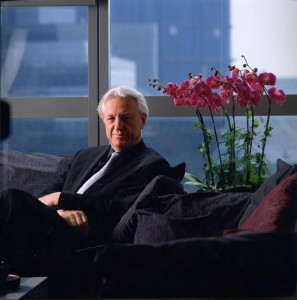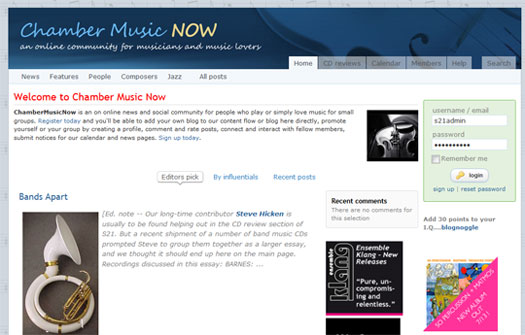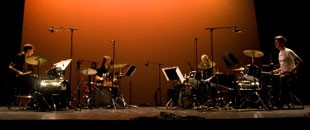 North Adams MA’s summer claim to fame, the Bang on a Can summer music fest, has been going great guns the past week, and wraps up Saturday, July 31, with the rural version of BOAC’s Marathon concert spectacle. Kicking off at 4pm, it will include Steve Reich’s Pulitzer Prize-winning Double Sextet, Arvo Part’s classic Fratres in a version for percussion and string orchestra; Julia Wolfe‘s blazing Fuel for string orchestra, with a film by legendary experimental filmmaker Bill Morrison (Decasia). Plus a new work by Swiss post-jazz master and ECM records mainstay Nik Baertsch, Evan Ziporyn dressing up Balinese music in ripped jeans in his Music from Shadowbang, an ensemble of Uzbekis come half way around the globe just to shake up North Adams, Christine Southworth‘s electrifying concerto Zap originally written for Van de Graaf generator and ensemble, pattern master Tom Johnson‘s translation of an ancient Indian math problem into a minimalist masterpiece, and much more. Tickets are $22, and directions are here. If you’re adventurous, free and mobile it sounds like a great way to escape the city swelter.
North Adams MA’s summer claim to fame, the Bang on a Can summer music fest, has been going great guns the past week, and wraps up Saturday, July 31, with the rural version of BOAC’s Marathon concert spectacle. Kicking off at 4pm, it will include Steve Reich’s Pulitzer Prize-winning Double Sextet, Arvo Part’s classic Fratres in a version for percussion and string orchestra; Julia Wolfe‘s blazing Fuel for string orchestra, with a film by legendary experimental filmmaker Bill Morrison (Decasia). Plus a new work by Swiss post-jazz master and ECM records mainstay Nik Baertsch, Evan Ziporyn dressing up Balinese music in ripped jeans in his Music from Shadowbang, an ensemble of Uzbekis come half way around the globe just to shake up North Adams, Christine Southworth‘s electrifying concerto Zap originally written for Van de Graaf generator and ensemble, pattern master Tom Johnson‘s translation of an ancient Indian math problem into a minimalist masterpiece, and much more. Tickets are $22, and directions are here. If you’re adventurous, free and mobile it sounds like a great way to escape the city swelter.
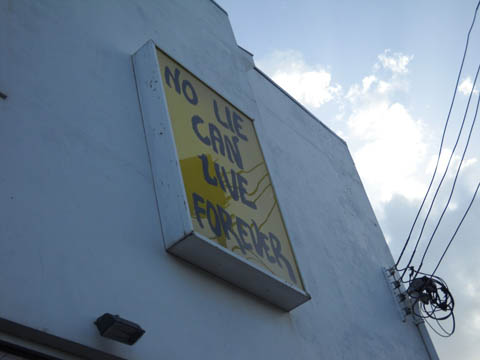
Outside the Eldorado Ballroom, Houston, TX (Photo by Chris Becker)
“ …(Houston is) one of the epicenters of noise bands and experimental music. Nobody even knows that, you know? ” Dan Workman of Houston’s Sugarhill Studios.
Here’s an excerpt of a recording I made of a Houston thunderstorm using a Zoom H4 recorder positioned just behind the front screen door to our house. You might want to turn down the volume about half way through if you listen to this headphones:
Part One
New York City – the city where I lived for twelve years before relocating to Houston, Texas – is LOUD. In my mind’s ear, I can STILL hear the car horns, the jackhammers, the fire truck sirens (we lived one block away from a fire station), the garbage trucks flipping over dumpsters filled with glass and concrete (BEEP! BEEP! BEEP! BEEP!) and…the subways. Oh Lord, the SUBWAYS! Two musician friends of mine wore earplugs every time they traveled underground. My wife ALWAYS covered her ears when the trains screeched to a halt at the platforms. Loudspeakers in the stations and on the trains intermittently blared out jaunty yet nearly incomprehensible warnings about rerouted trains and “suspicious packages.” (Remember…if you SEE something, SAY something!) And microphone feedback? The MTA’s gotcha covered.
Quick! Without thinking, imitate a New Yorker! You started YELLING, right?
So being a sensitive composer with sensitive ears, the first thing I noticed about Houston once we’d moved down here is how much quieter it is compared to New York City. And what tweaked my ears my first few weeks on the ground wasn’t the omnipresent hum of the Interstate 610 loop. It was the unpredictable antiphonal chatter of Houston’s bird population. The screeches and cooing were so intriguing to me, I spent the first couple months in our new city composing a piece of “musique concrete” utilizing several recordings I’d made of the birds in our front and back yards. There is a truly rural almost wild (as in wilderness) vibe to the city outside of downtown and the aforementioned beltways.
How did a city that to my ears is so much quieter than NYC come to be known as an “epicenter of noise”? Make no mistake, some of the Houston noise artists I’ve checked out make Nine Inch Nails sound like Sting. But one thing the Houston musicians I’ve reached out to regarding the “noise” scene agree on is that one person’s “noise” is another’s poetry. The hierarchal notion that a note from a clarinet somehow contains more emotional profundity than the sound of a hammer hitting a nail doesn’t really exist in the minds of (most) 21st century musicians (One of my “non-noise” composer friends pointed out that noise just like “music” can “evoke a wide range of sentiment”). But my research yielded so MANY Texas musicians either explicitly flying the “noise” flag (Concrete Violin, Spike The Percussionist, Richard Ramirez) or so loosely attached to however one might define “noise” (the grime meets speed metal music of B L A C K I E is one such example) that I wondered who or what exactly I could write about in this dispatch.
It occurs to me that one of my favorite recordings, “Dark Was The Night, Cold Was The Ground,” was created by a Texan (Blind Willie Johnson in case you didn’t know). The timbre Johnson’s vocal lies somewhere between a whisper and a scream while his phrasing conveys a feeling of both defiance and resignation. Consider the title Johnson gave to this recording. Has the uniquely Southwestern connection to the earth – the dirt that we all will return to one day – disappeared in the years since the 1920’s when Johnson tracked his performance? I don’t think so. And in the noise of that recording (the slide on the guitar strings…the rumble of the grooves of the record itself…) is there some precedent for the Dadist freak outs of Houston ’s Red Krayola? Or the electric jug playing of the 13th Floor Elevators? Or the stinging strings of Lightning Hopkins, Clarence “Gatemouth” Brown, or Little Joe Washington?
Perhaps “noise” – that succinct descriptive noun – is actually in practice a portal to a sensory experience that isn’t so easy to describe but one we immediately feel and understand. To quote Morton Feldman: “…these moments when one loses control…and with a thrust there is no sound, no tone…nothing left but the significance of our first breath.”
Like rain and thunder. Or “cicadas making noise…” Or the crazy Houston doves that carry on their pygmy like conversations from the trees around my house from sun up to sun down.
Part Two
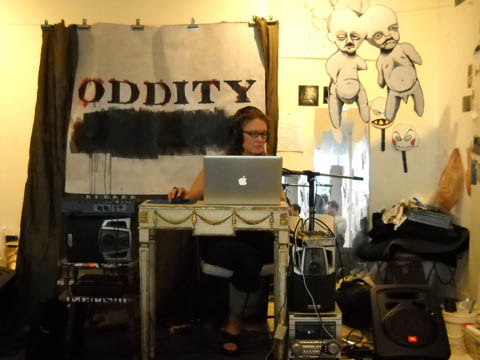
Alexandra Marculewicz Adshead at Labotanica (Photo by Chris Becker)
Houston’s gallery and performance space Labotanica is currently hosting a monthly concert series called hereherhear that features women in experimental music. The first concert in June included artists from Houston, Baltimore, and New York. Last Friday, I attended July’s hereherhear concert event featuring the collective Pear Prickley Pear, vocalist/ composer Alexandra Marculewicz Adshead, and DJ/Electronic artist Khrystah Gorham. On display at Labotanica was Yet Torres’ mixed media installation EYE-CANDY DELECTABLY which explores objectification and the body via Torres’ own mysterious, grotesque, and at times humorous iconography. Plenty of people turned up for the concert, and I was happy to see that at a little after 7pm the performers would be playing to a full house.
Earlier in July, Alexandra invited members of the Houston community to email her mp3s of samples that she might incorporate into her performance at Labotanica. I responded with my front and back yard bird piece and was delighted when Alexandra contacted me to say that she would indeed use it for her upcoming gig. Samples from Pear Prickley Pear and composer Steve Layton would also become a part of Alexandra’s show.
Alexandra’s recorded works blend composed structures with improvised sometimes heavily processed vocals that at times is character driven or seemingly inspired by the sounds of nature, animals, and even her one-year old daughter. What struck me when I first listened to her music online was the sound of her voice – her tone and the emotive quality it contained. A voice sometimes jumps out at you in that way.
In performance, Alexandra utilized the laptop computer to play back the composed structures of her works while processing her live vocals through a variety of unpredictable effects. In one piece, she told the story of a woman’s descent into madness with a delivery that initially sounded as if she were reading a slightly unnerving bedtime story until flange and delay transformed her spoken words into the sound of the voice you hear when your frontal lobe isn’t functioning. Her closing piece did indeed incorporate my bird (noise?) piece into multidimensional landscape where slowly looping chorale-like vocals rose to several crescendos before morphing dramatically into a texture that included percussive effects and (more) bird song from Layton. The whole set was a thoughtful and engaging blend of techniques and technologies.
Outro
I wonder if “noise” as Houston has come to know it is due for yet another wave of creative development. For a movement that is by nature very “underground” – much of Houston’s experimental artists are well documented thanks to the Internet and what I believe is a very Texan impulse to preserve history (and share some good stories) in words both written and sung. Or screamed. Houston is a comfortable and nurturing place for experimental artists. And there are probably many reasons for that fact that I have yet to sort out.
(Special thanks to Joseph Benzola, Douglas Henderson, Mark Kemp, Daniel Salazar, Ryan Supak, John Stone, Yet Torres, and Michael Vincent Waller for their sharing with me their thoughts on noise.)
 Montana native Christopher Stark has won American Composers Orchestra’s 2010 Underwood Commission, earning him a $15,000 purse for a work to be premiered by ACO in a future season. Chosen from seven finalists during ACO’s 19th annual Underwood New Music Readings on May 21 and 22, Stark won the top prize with his work Ignatian Exercises.
Montana native Christopher Stark has won American Composers Orchestra’s 2010 Underwood Commission, earning him a $15,000 purse for a work to be premiered by ACO in a future season. Chosen from seven finalists during ACO’s 19th annual Underwood New Music Readings on May 21 and 22, Stark won the top prize with his work Ignatian Exercises.
Born in 1980, Christopher Stark spent his formative years in rural western Montana. His music is deeply rooted in the American West, always seeking to capture the expansive energy of Montana’s quintessential American landscape. In addition to ACO, he has worked with ensembles such as Brave New Works, the Momenta Quartet, the Israeli Chamber Project, Janus Trio, NeXT Ens, the Tipping Point Saxophone Quartet, and Juventas. The Underwood Commission is Stark’s first from a professional orchestra.
Stark is currently a doctoral student in composition at Cornell University, studying with Roberto Sierra and Steven Stucky. He previously studied at the Freie Universität Berlin, the Cincinnati Conservatory, and the University of Montana. At these institutions and abroad in Vienna, he studied with notable composers Samuel Adler, Michael Fiday, Joel Hoffman, David Maslanka, Charles Nichols, Wolfram Wagner, and Patrick Williams.
For the first time this year, audience members at the New Music Readings had a chance to make their voices heard through a new Audience Choice Award. On both May 21 and 22, audience members voted for their favorite pieces. The winner of the Audience Choice Award was composer Ricardo Romaneiro, for his piece Sombras. As the winner, Romaneiro was commissioned to compose an original mobile phone ringtone, available to everyone who voted, free of charge.
Naxos Records’ founder and CEO Klaus Heymann meets me in a café, downstairs in the midtown hotel where he’s staying in Manhattan. Heymann is on a trip to the US in which he’s doing press meetings and presentations in New York, followed by meetings with the Naxos America team at their base of operations in Franklin, Tennessee. Then he’s off to the West Coast for still more meetings. Finally, he gets to go back to his home in Hong Kong. When I remark about the seemingly whirlwind nature of the trip, Heymann says, “International travel is expensive these days. It’s best to take care of all the business I can in a single trip.”
But while Heymann is averse to wasting money on the jet-setting model of yesterday’s record labels, he’s certainly willing to invest the label’s resources where it counts: on the music! The imprint has a catalog of nearly 4000 titles, boasting both tremendous depth of repertoire and many fine performances. And it’s growing continuously. When I suggest that we discuss the projects in the offing, Heymann brings out a list of recordings that is jaw dropping in its comprehensiveness. Of course, I ask first about the area dearest to my heart (and most germane to my writing beat).
“Let’s see, the American Classics series: we have 73 titles ‘in the pipeline,’” says Heymann.
The list of American recordings on the way includes a number of famous figures: Aaron Copland, John Corigliano, Richard Danielpour, and Michael Torke among them. But there are a number of projects by composers who, while they may be discussed on Sequenza 21, certainly aren’t yet household names: Paul Moravec, Roberto Sierra, David Post, and too many others to recount here.
I notice a couple of Sequenza 21’s contributors on the list too: Judith Lang Zaimont and Lawrence Dillon. There’s a significant commitment to diversity. Women composers such as Zaimont and Jennifer Higdon and conductors such as Jo Ann Falletta and Maren Alsop feature prominently in Naxos’ future plans, as do artists from a wide range of ethnic backgrounds. And Heymann doesn’t seem to have a style agenda: Naxos presents both Uptown and Downtown composers and seemingly everything in between. I’m particularly excited to hear about a forthcoming recording by the New England Conservatory Percussion Ensemble (including Elliott Carter’s Tintinnabuli!).
Is there a composer who’s conspicuous in his absence? “No more John Adams for a while,” says Heymann. Seeing my eyes widen, he continues, ”He made some very disparaging comments about Naxos in an interview … budget label … mediocre performances. It was very hurtful to a number of people at the label who’ve advocated for his music.”
This is the first I’ve heard of the interview, which I later find online in Newsweek. Given that Naxos’ recently released a fine recording of Nixon in China, the ingratitude is stunning. (In trying to reach Adams for comment, I’m told that he’s on “media blackout” while finishing a commission).
In addition to our appetite-whetting discussion of upcoming recordings, Heymann enthuses about a variety of methods for delivering music to consumers. On the day of our meeting, he’s is also booked to demonstrate Naxos’ first Blu-ray audio recordings. The initial run of ten titles is slated for release in Fall 2010. They include a recording of a contemporary American work: John Corigliano’s Circus Maximus.
Heymann says, “When we recorded Circus Maximus, I promised John that we would release it in surround – that’s how it was meant to be heard! SACD seems to be a declining format, so we waited … and now will release it on Blu-ray.”
While Naxos has remained committed to releasing recordings via physical media – CD, DVD, Blu-ray – they are also continuing to diversify their collection, providing a plethora of format offerings for the digital age, from conventional MP3s to streaming services such as Naxos Audio Library and Naxos Radio.
“I’m very interested in the technology side of things,” says Heymann. “When the iPod first came out, I was certain early on that it would be a transitional device – that streaming would be the wave of the future. And as the technology improves, we’re streaming better and better quality audio online. Sales of our streaming services are improving while downloads seem to be stagnating. Of course, no one knows what the future will bring, so we’re remaining flexible. We’ve even recently released a recording on a USB stick: five hours of Chopin. The packaging looks like a CD jewel case, but the stick delivers higher quality audio – and more of it – than a conventional CD.”
The Audio Library is available through my university, and I’ve found it to be an invaluable resource in the classroom. It doesn’t just contain Naxos’ recordings; there are over 200 labels represented. I mention wishing that so many of the historic recordings in its database weren’t barred in the US.
“Me too,” says Heymann ruefully. “But that’s something to take up with your congressman; the laws in America are restrictive in that regard.”
Naxos has recently added a Video Library. It currently has around 400 titles. “There are more to come,” says Heymann. “It won’t have 44,000 titles like the Audio Library does, but our near term goal is to get it up to around a thousand. In addition to operas, we’re planning to include educational programs and plays.”
Despite the myriad challenges facing the record industry, Naxos seems to be a flexible player poised to take classical music into the future. Heymann says, ““People talk about piracy and illegal downloading: both of which are indeed problems. But seeing the amount of young people who are studying classical music, I remain optimistic about music’s future.”
He continues, “We don’t make a lot of money on most of our recordings. Things like The Best of Chopin sell well. But then consider most of the recordings in the American Classics series; we don’t release them because they’re lucrative, but because it’s important to do so. Naxos has created a catalog that I’m proud of – one that‘s now an intrinsic part of the classical music landscape.”
 If you’re an aspiring Wagnerian, this probably won’t interest you much but the nice folks at Hartford Opera Theater (HOT) are looking for scores for five short operas that will be learned, staged, rehearsed, and performed in the span of 48 hours, beginning on November 12 and culminating in a final performance on Sunday, November 14.
If you’re an aspiring Wagnerian, this probably won’t interest you much but the nice folks at Hartford Opera Theater (HOT) are looking for scores for five short operas that will be learned, staged, rehearsed, and performed in the span of 48 hours, beginning on November 12 and culminating in a final performance on Sunday, November 14.
Composers are asked to submit opera scores written for 2-3 singers, with at least one part written for a soprano or mezzo-soprano. HOT advises that scores with more opportunities for women will be more likely to be chosen for this event. The operas may be no longer than 10 minutes in length, English only, and written for piano or a piano reduction. Material for librettos should be original, in the public domain, or if copyrighted permission must be submitted with the score. Each opera should require minimal sets and costumes.
If you happen to one of those chosen to participate in the event–called “New in November” (not to be confused with New York’s own ongoing “So, New?” festival)–are welcome to attend the rehearsal if you’re open to minor revisions and changes. You get paid nothing and no travel expenses and it would be very rude of you to ask if the singers, piano player or director are getting paid.
The deadline for submissions is Wednesday, September 1, 2010. Scores may be mailed to: Hartford Opera Theater, P.O. Box 270108 West Hartford, CT 06127-0108. Electronic submissions will also be accepted at this email address. More information can be found on the website.
The picture is from an earlier HOT production–Tom Sawyer: A Chamber Opera by Phillip Martin. You can watch a movie of the whole opera here.
My graduate history seminar on minimalism starts next week at Westminster Choir College. I’ll be teaching the course in a three-week intensive session – three hours a day/four days a week. In that time – just 12 meetings in all – we need to cover a lot of ground. There are three assigned texts: Minimalism: Origins by Edward Strickland, Repeating Ourselves by Robert Fink, and Music Downtown by Kyle Gann, as well as a number of supplemental readings (lots of Tom Johnson) and listening assignments.
Each student will be required to make a class presentation and write a substantial research paper. Those in the group who like to compose will write a minimal piece for the class to perform. In an exciting development, one of my students, who is a high school choir director, has already been in touch with Terry Riley’s “people” about Another Secret eQuation, his recent choral piece for young people, and will be researching it for her paper.
While I’ve been thinking about and prepping the course for a long while, I’m, of course, curious about what the Sequenza 21 community thinks. What do you consider to be an “all killer/no filler” listening list for graduate students studying minimalism – many of them for the first time. The comments section is open!
By the way, those who are interested may feel free to contact me after the class is over for a set of the handouts/slides.
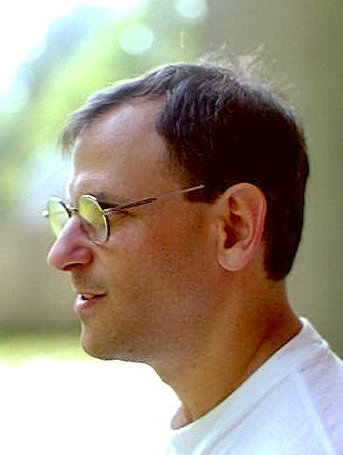 Why do some extraordinarily talented people never show up on the radar? Eric Lyon is one such unsung genius. I understand he’s been impressing folks in Brooklyn the past few years, and he wowed them at the Bonk Festival of Music in Tampa for over a decade (not to say that knocking them dead at the Bonk Festival is going to boost anyone’s career). But unless you go to ICMC or SEAMUS or have had the good fortune to live somewhere that Eric regularly presented his music, you probably don’t know about him.
Why do some extraordinarily talented people never show up on the radar? Eric Lyon is one such unsung genius. I understand he’s been impressing folks in Brooklyn the past few years, and he wowed them at the Bonk Festival of Music in Tampa for over a decade (not to say that knocking them dead at the Bonk Festival is going to boost anyone’s career). But unless you go to ICMC or SEAMUS or have had the good fortune to live somewhere that Eric regularly presented his music, you probably don’t know about him.
Whatever the reason, it is a cosmic injustice of the highest magnitude that Eric Lyon is on the far side of his 40s and hasn’t had a major commission yet or a big label recording or received tenure somewhere.
I just posted a review of an all-Lyon concert at UC San Diego back in 1993. I wrote many favorable reviews of Eric’s work back in the 90s, and I’ll be posting them on my blog to try to convey to readers how exciting it was to see the words “Eric Lyon” and “world premiere” on a concert program back then.
Read the review here.
I found one of my favorite reviews from the 1990’s (Roger Reynolds’s Dreaming and Harvey Sollberger’s Passages), and posted it here.
There was a minor controversy surrounding Roger Reynolds’s commission from the San Diego Symphony (his first from the Symphony after living in San Diego for over 2 decades). Dreaming had been on the schedule for performance the season before, but the premiere was cancelled. Theories about the cancellation, many involving Symphony Board intrigue, bounced around the UC San Diego Music Dept.
Several months later I interviewed Igor Gruppman, the concertmaster for the SDS. He related that the musicians have a clause in their contract allowing them the right to cancel if they don’t get parts a certain number of weeks ahead of a world premiere; apparently Reynolds’s parts got to the players too close to the performance date, and they voted to reschedule. The performance I reviewed months later sounded great, so hopefully everything worked out for all parties.
I can’t recall the San Diego Symphony playing any contemporary music as challenging as Reynolds’s work on a main subscription series concert since this performance. More’s the pity, as the Symphony is playing even better now than when they tackled Dreaming.
It’s summer, it’s hot, and the music scene here in the Center of the Universe is fairly slow so I thought it might be a good time to get some feedback on an unfinished “piece” I’ve been working on for a couple of weeks. It’s a website that looks like this:
Actually, you don’t have to look at the picture; it’s already up on the web at Chamber Music Now so I guess you might consider this a “beta” launch. I built it because I love to play with new software and the nice Thracians who make the software I use on my commercial efforts (like this one) have just released a brand new version called Wordframe Integra. They gave me a “sandbox” to play with and I (with constant handholding from Boz, the guy who wrote the Integra program, in Plovdiv) created a new chamber music community site. Now, I have to figure out what to do with it because, frankly, seriously growing an audience for a web site is hard work and, so far, I’ve been too hot and lazy to even write a proper how-to-use section.
In any event, the site is “live” and the functionality (except for the Profiles which Boz is still feverishly coding) is in place. If you go there and register, there are a lot of neat things you can do. You can create a blog post (which will appear on the front page once I approve it), write a CD review, and post information to the Calendar page. If you already have a blog, you can add it to the front page content flow by adding your RSS feed to the thing called Autopost. Every time you publish something on your blog, I’ll get a copy of it and, if it’s on target (i.e. about chamber music), I’ll use it on CMN and you’ll get more readers and thus become richer and more famous. The concept, which is about the only thing I can claim credit for, is that this would be the ultimate DIY music community.
All the stuff that is there now is lifted directly from Sequenza21 but I’ll be recruiting some chamber music groups to add their stuff when I get around to it.
Give it a try. You’ll notice that there is a lot of segmentation within the front page, CD review and Calendar pages which should make it easier to categorize and find stuff. I welcome your feedback on both the idea itself and the execution. If there are functions or features you’d like to see, tell me now while I still have a Bulgarian genius to help me for free.
The Varèse (R)evolution is tonight and tomorrow at Lincoln Center. Thanks to Alex Ross for pointing out this YouTube clip.
